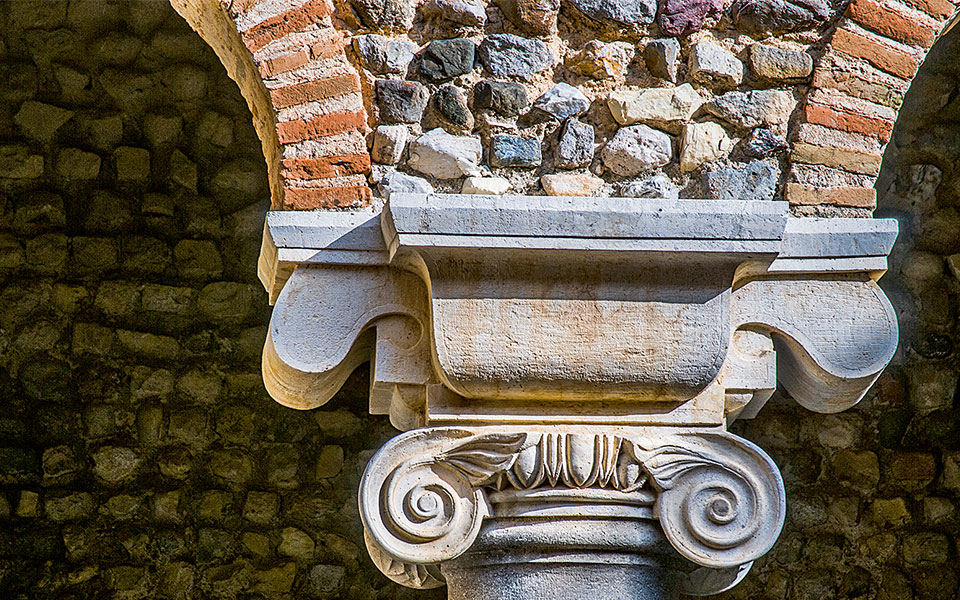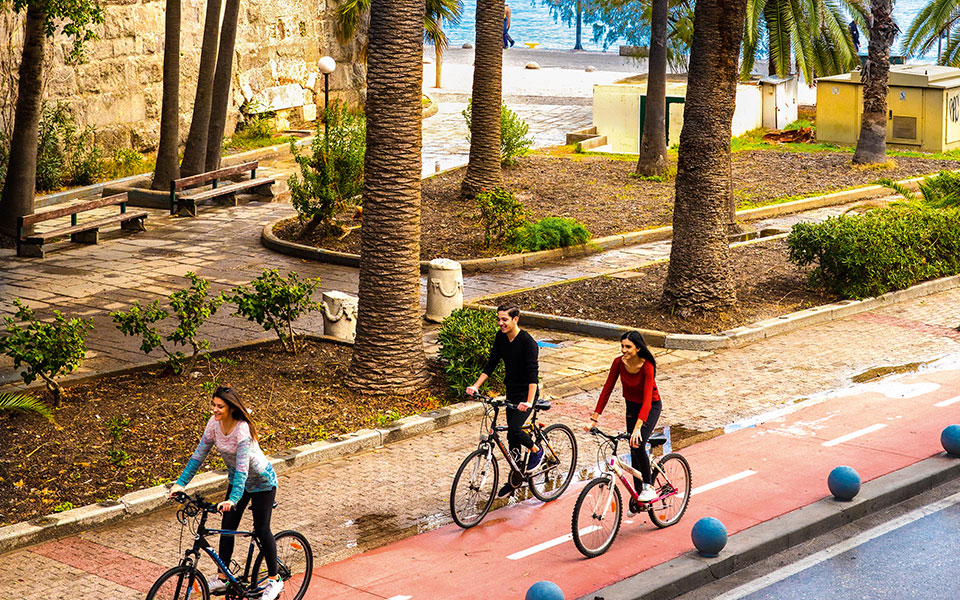Planning a trip to Kos? Get the most out of the island with our latest guide to the best the island has to offer.
EXPLORE
LOOK AROUND: You can get a quick read of Kos’ entire history just by standing in the middle of Eleftherias (Freedom) Square and doing a slow twirl: you’ll see a section of the city’s ancient wall (366 BC); the late 18th-c. Defterdar Mosque (minus the minaret which collapsed in an earthquake last summer) and buildings dating from the Italian occupation. One of these houses is the sculpture-filled Archaeological Museum of Kos (Open Tue-Sun 08:00-20:00).
A WALK IN THE PAST: Were it not for last year’s earthquake, which caused heavy damages to the island’s iconic Castle of Nerantzia, this would have been the starting point of your exploration. Instead, you can start early with a stroll through the ruins at the ancient Agora (366 BC), before continuing on to the nearby Western Archaeological Zone, whose important structures and monuments include Thermes, the ancient stadium, the Ksiston (the stoa where athletes would train) of the ancient gymnasium, mosaics, and the Nymphaion building. Directly opposite, you’ll see the restored Roman Odeon (1st-2nd c. AD) and, a short walk away, you’ll come across the famous Casa Romana, the only renovated house from the Roman era in Greece.
Info
- Area: 287 sq. km.
- Population: 33,390 (2011 census)
- Distance: 200 (sea miles from Piraeus)
- Highest Peak: 846m (Mt Dikaios)

© Clairy Moustafellou

© Clairy Moustafellou

© Clairy Moustafellou
FURTHER AFIELD: For other interesting ruins, head to Palio Pyli, a site approximately 10km from Kos Town, where a Byzantine village once stood. The half-hour hike up to its 10th-11th century castle may be strenuous when it’s hot, but you’ll be rewarded by a refreshing breeze and an incredible view. A walk along the paths through the greenery at the base of the hill is also worthwhile, particularly for the three Byzantine churches that still stand there – Kastriani, Aghios Antonios and Taxiarches. You can wrap it all up with some well-deserved refreshments or a meal at Oria, a very nice taverna nearby.
BEFORE SUNSET: Late afternoon is the perfect time to take a walk around Antimachia Castle (25km from Kos Town), a splendid fortress built by the Knights of St John that becomes all the more dramatic in the softer light at the end of day. Cross the threshold of the main gate, wander among the ruins and churches of this once-bustling settlement, and enjoy the view from the remaining battlements. You can then walk down the cobbled trail to the seaside village of Kardamena and enjoy refreshments and sweets at the quaint little café Lovemade, or drop by Christina’s Shop, where you can see old looms in use and buy carpets, rag rugs and bags.

© Dionysis Kouris
EXPERIENCE
RENT A BIKE: One of the best ways to get around is by bicycle, thanks to the 13km-long bicycle path running along the coast from Faros Beach in the east to Psalidi Beach to the west. It also crosses the center of Kos Town along Ippokratous and Vassileos Pavlou Streets, linking the town’s two archaeological parks (the Western Archaeological Zone and the Ancient Agora). For tours off the beaten path, contact the Women Cyclists of Kos (Tel. (+30) 697.700.0901).
MORE THAN A BEACH: When it comes to swimming, Aghios Stefanos is a very popular beach, but it’s also quite special; it’s located beside two Early Christian churches from the 5th-6th century and looks out onto the islet of Kastri. Take a tour of the archaeological site on the rocky headland and have a go at jumping in the sea from the nearby rocks, just like the kids do.

© Giorgos Ppapostolou
BEACHES – LESS IS MORE: Kos boasts more than 70km of beaches – approximately two-thirds of its coastline. Most are covered with sun loungers and umbrellas, so we’ll just mention our own favorites: Cavo Paradiso, at the end of a dirt road on the western coast is, hands down, the nicest. It’s pretty hard to reach, which means that it doesn’t usually get crowded. In fact, you’ll probably feel like you’re on some other, quieter island, although there is a refreshment stand where you can get all your basic supplies. On the way there, there are a few quiet sandy beaches with prickly cedars in the area of Ai-Yiannis Theologos.
At the opposite end of the island, you can enjoy a unique bathing experience at the beach of Embros Thermes, aka Therma, where a ring of rocks just off the beach forms a small saltwater “pond” and healing 30-50°C water bubbles up from the bowels of the earth. The experience is even more magical at night.

© Clairy Moustafellou

© Clairy Moustafellou
WATER SPORTS: Adrenaline buffs will find no shortage of thrills on Kos, where almost every beach has a watersports center offering everything from windsurfing, kite surfing, fly boarding, SUP, parasailing and kayaking to jet skis, wakeboards and bananas. Experienced windsurfers and kite surfers tend to congregate at the large and popular beaches of Psalidi (west of the town) and Marmari (on the northern coast), although beginners are better off at Mastichari to the west.
SERIOUS WALKING: Try the trail leading up from the village of Zia to Christos Peak on Mt Dikaios (1-1.5 hours) or take part in an organized trek with the local group run by Sofia Karagianni (Tel. (+30) 694.538.5330).
FOR KIDS, TOO: Spend an afternoon at the Park of Colors (Amerikis & Psaron, Kos Town), an initiative launched by artist Manthos Arbilias; there’s a bar, as well as a great play area for kids, and the venue hosts puppet and shadow-puppet theater performances and live music shows.
CUTE THINGS: For special handmade gifts or souvenirs, try the Imaginarium Gallery (Platanos Square), the Lydia Jewelry Store (3 Filita) or the Art Zone (32 Kolokotroni).

© Giannis Giannelos
FOCUS – The island of healing, Asclepius and Hippocrates.
As medical care in Classical Greece advanced (5th-4th c. BC) and patients had access to more science-based treatments, a growing number of respected specialists appeared, most notably Hippocrates of Kos (ca. 460-ca. 370 BC). Trained at the Asclepeion, a Koan sanctuary dedicated to the divine healer Asclepius and his daughter Hygeia (Health, Hygiene), Hippocrates became a skilled physician and teacher, traveled widely and eventually founded his own school on Kos (late 5th c. BC). He also wrote the influential Hippocratic Oath (ca. 400 BC), a code of medical ethics still followed today. The Asclepeion occupies a hillside with three enormous terraces, massive retaining walls and interconnecting monumental staircases – an elegantly colonnaded “hospital” of particular fame among the Romans. – John Leonard

© Clairy Moustafellou
TASTE
A TASTY START: If you’re in Kos Town for breakfast, opt for Greek classics such as a cheese pie drizzled with honey or a bougatsa cream pie from the kafeneio Tsivrinis (also known as Ariston) at Kazouli Square. A favorite among locals is a toasted sandwich dubbed the Aghia Paraskevi, after the church next to which the small, unnamed café that makes it has been located since 1972.
BEST IN TOWN: Kos is not renowned for its traditional cuisine, but you can eat well in town in the courtyards of Pote tin Kyriaki (“Never on Sunday,” 9 Pisandrou) and Evdokia Mummy’s Cooking (13 Bouboulinas) for Greek homestyle casseroles; at Lambros (21 Psaron) for kebabs; and, for modern cuisine, at Broadway (36 Megalou Alexandrou) and H2O, the Kos Aktis Art Hotel restaurant. For exquisite seafood dishes, the best choices are both on G. Averoff Street: Barbouni Restaurant (No. 26) and the taverna Nikolas o Psaras (No. 21). For cocktails with a view of the port, try Sitar (15 Riga Feraiou) or Kaseta (4 Akti Miaouli)

© Dionysis Kouris
HIGHLANDS HIGHLIGHTS: The abandoned village of Haihoutes on the slopes of Mt Dikaios is experiencing something of a revival. At its quiet little kafeneio you can pick from a great selection of meze, and take in the odd bit of live music, ranging from rebetiko to jazz (Tel. (+30) 693.263.7905). Other highlights in the highlands include the amazing taverna Casino (Tel. (+30) 22420.302.41) in the village of Asomatos, and the cult kafeneio/antique shop Oraia Ellas (Tel. (+30) 22420.690.04) in Lagoudi.
EASTERN DELIGHTS: The Muslim village of Platani, not far from Kos Town, is worth visiting for the amazing kebabs and other Middle Eastern dishes served at the tavernas Arap and Hasan. Don’t leave without trying a slice of ravani (sweet semolina cake) with a scoop of mastic-flavored ice cream, or some sweet tomato preserves at the Paradosi dessert shop.
EDIBLE SOUVENIRS: Buy some possa (a local cheese that’s aged in wine for five months) from Yiannou’s Dairy in Pyli, or a jar of honey from Melissa in Kefalos. Of the island’s wineries, two are open for visitors: Triantafyllopoulos in Ziprai and Hatziemmanouil in Linopoti. Both produce award-winning wines that you can buy or sample on the spot.












